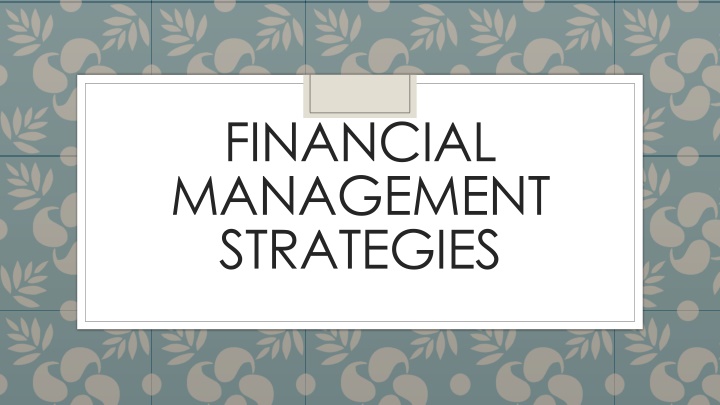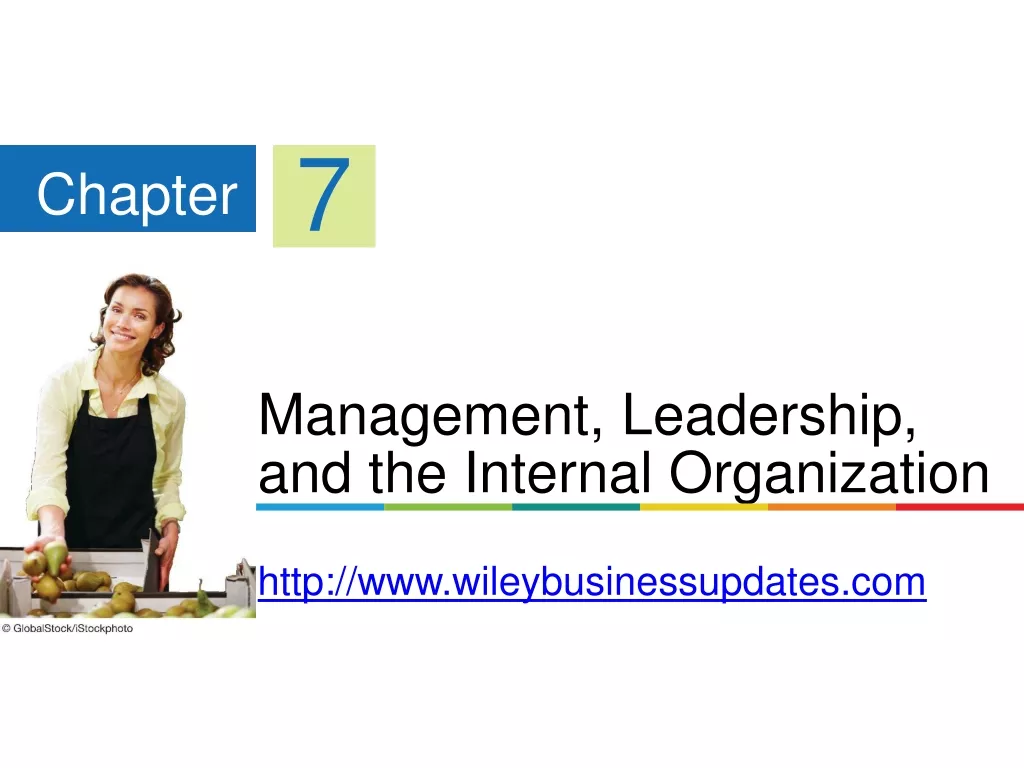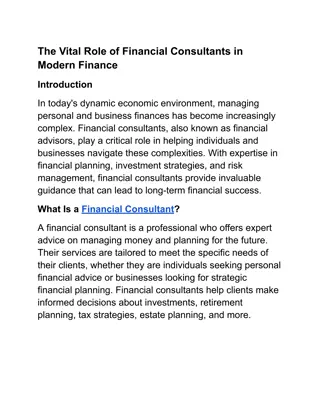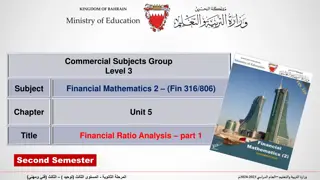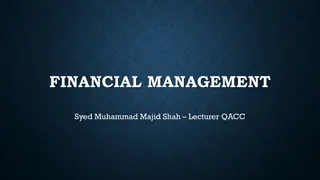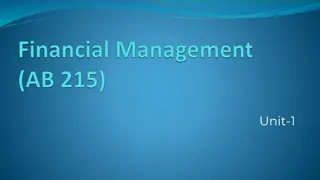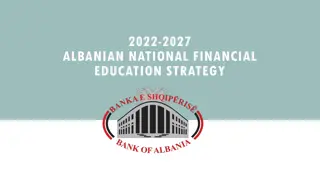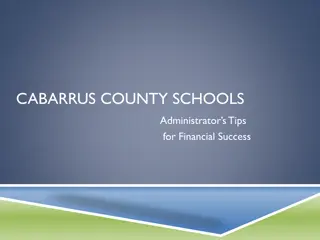Effective Financial Management for Business Success
Effective cash flow management is crucial for businesses to thrive. Businesses need to carefully manage their cash flow to ensure steady income, timely payment of expenses, and proper planning for seasonal fluctuations. Constructing cash flow statements and monitoring cash inflows and outflows are essential components of financial planning. By understanding the importance of managing cash flow effectively, businesses can anticipate challenges and plan accordingly for sustained success.
Download Presentation

Please find below an Image/Link to download the presentation.
The content on the website is provided AS IS for your information and personal use only. It may not be sold, licensed, or shared on other websites without obtaining consent from the author.If you encounter any issues during the download, it is possible that the publisher has removed the file from their server.
You are allowed to download the files provided on this website for personal or commercial use, subject to the condition that they are used lawfully. All files are the property of their respective owners.
The content on the website is provided AS IS for your information and personal use only. It may not be sold, licensed, or shared on other websites without obtaining consent from the author.
E N D
Presentation Transcript
FINANCIAL MANAGEMENT STRATEGIES
Cash flow in a business needs to be carefully managed. Cash flow management refers to the way the movement (or flow) of cash from one aspect of the business to another is managed. Initially cash is needed to pay expenses, such as wages, as raw materials are transformed into finished goods. Cash is then locked up in inventory or stock. When those goods are sold to customers, cash is received. The cash can then be used again to pay expenses such as wages.
Most large manufacturing businesses sell their products to customers on credit. This means that the customer gets the goods with an invoice attached and will pay the account later. Unless the cash is collected from the customer, it will not be available to pay the next round of expenses! And it is not an easy task to collect debts as they fall due. People want to put off paying.
Cash flow statements The first aspect of effective financial planning is to construct a cash flow statement. A cash flow statement predicts the monthly inflows and outflows of cash. An inflow, for example, occurs when goods are sold or customers pay their debts if the goods were sold on credit. An outflow is a payment for expenses such as wages or an insurance premium. It is much easier to predict monthly outflows of cash than inflows. Think about why. However, even inflows can be reasonably accurately predicted on the basis of last year s sales and sales budgets.
This is how a simplified cash flow statement would look.
Where do you think the opening balance of $28 000 in January came from? Of course that was the cash in the bank on the 31st December 2014 and it becomes the opening balance for the 1st January 2015. The cash inflows represent income from sales of goods or the collection of customer debts. The outflows represent payments to suppliers and for expenses such as wages, leasing payments, electricity usage and so on.
Did you notice the negative closing balances from July to October? Why were sales of ice cream so low from May to August? Obviously it is a seasonal thing - people buy less ice cream in winter. How will Magic Ice Creams Pty Ltd pay their bills in July, August and September? It is most important the managers of this business plan for this problem. Perhaps the quickest and most convenient way of dealing with the problem would be to arrange a $20,000 overdraft. Another aspect of the effective management of this cash flow is the large amounts of cash in the bank in December, January, February, March, April and May. If this cash were invested in marketable securities (loans to other businesses), it would earn additional cash. Obviously cash flows need to be carefully managed.
Distribution of payments Businesses often have a choice as to when many bills are paid. Lease payments, for example, can be linked to the cash flow cycle. Most wheat farmers link the lease payments for tractors and headers to the once-a-year payment for their wheat. Insurance premiums are another example where the payment can be made at any time of the year. It is important to link outflows, whenever possible, to months with surplus cash.
Discounts for early payment Discounts for early payments involve an offer where, for example, the customer can deduct, say 5 %, if the bill is paid in 7 days rather than the normal 30 days. In this way cash moves from one section of the business (accounts receivable) to another section of the business - accounts payable and expenses - more quickly. The cash is available to pay wages, for example, more quickly. Discounts for early payment can often be a cheaper option compared to using an overdraft when there is a cash deficit.
Factoring You will remember from the earlier section on short-term borrowing that factoring is an external source of finance. Factoring refers to the sale of customer debts to a financier. It is an important strategy for cash-flow management even though the cost of factoring adds to business expenses. Typically, this expense is about 3%, so it can be significant.
However, it can be a very important strategy for managing the cash flow of rapidly growing businesses. In this case, there is always a great deal of pressure to pay suppliers, and factoring provides quick cash. The pressure occurs because of the need to move cash from accounts receivable to accounts payable in a very short time period. It is important to augment a factoring strategy with an effective credit policy so that customer debts are collected efficiently and the need to factor is minimised.
Working capital is essential in nearly all businesses. Working capital or liquidity management is all about paying suppliers bills (or accounts payable) and other expenses as they fall due. The working capital ratio measures the ability of the business to pay short-term debts. We have already looked at the liquidity ratio in the financial ratios section of this topic. You will recall the liquidity ratio is the current ratio and the formula is: current ratio = current assets current liabilities.
The current ratio measures the businesss ability to pay short-term debts in terms of available current assets. However, liquidity in a business is the same concept as working capital. Another name for the current ratio is the working capital ratio.
Control of current assets - cash Cash is controlled by cash budgets. The cash budget sets out the anticipated sources and uses of cash on a monthly basis. The cash budget is both a planning and controlling tool. It enables managers to time the payment of significant ongoing expenses, such as insurance premiums, so that they are paid when there are cash surpluses. One important aspect of the cash budget is the fact that cash outflows are easier to predict accurately than cash inflows. This is because cash inflows depend on external factors such as customer demand.
Control of current assets - receivables Receivables are customer debts. Most businesses supply their customers on credit. When goods are sent to the customer, they include an invoice. The invoice sets out the type of good, the quantity and the price. There will also be a time period, usually ranging from 7 to 30 days, for payment of the invoice. The problem is that people are often reluctant to pay bills on time. Many businesses are also like this and customer debts need to be carefully managed to make sure that they are paid on time. There are a number of strategies that can be used.
They are: 1.Credit Policy 2.Factoring
1. Credit policy Businesses should have a credit policy. A credit policy is a set of guidelines to staff on how to monitor and collect customer debts. It is the most cost-effective way of managing customer debts. The credit policy manages customer debts by first setting a credit limit. The credit limit is the maximum value of credit the business is prepared to give to its customer. It is based on things like knowledge of the customer, past trading record and so on.
Next it is important to set the credit period. This refers to how long the customer can have the credit before the bill should be paid. Typically it is 30 days, but it varies with particular industries. For example, the grocery industry operates on a credit period of seven days.
The most important aspect of the credit policy is the collection policy. The collection policy is a guide to staff on what to do when customers fail to pay on time. The collection policy, for example, might advise staff to ring the customers and advise them of the trading period. Other customers who are badly overdue may need the threat of debt collectors. The collection policy provides advice to staff on a range of possible scenarios. It may be, for example, that when important customers are overdue on their payments, it is to be referred to senior management.
2. Factoring When a business is growing rapidly, factoring can be an important control of current assets - receivables. Factoring is where customer debts are sold to a financial institution. The financial institution collects the customer debt when it is due to be paid and the business gets immediate cash. Financial institutions charge a fee for this service.
Control of current assets - inventories Inventories are often one of the largest assets for many businesses. Inventories refer to stored resources such as raw materials, work- in-progress, component parts or finished goods. Retail businesses have mostly finished goods as inventory. They tend to call it inventory stock. On the other hand, manufacturing businesses often hold a large amount of raw materials or component parts in their inventory because the finished goods are usually sent as soon as they are manufactured to customers.
Businesses need inventory so they can respond quickly to customer orders. If the business cannot respond quickly, the customers may take their orders to competitors. One of the best ways to manage inventory is through an inventory policy.
1. Inventory policy An inventory policy manages inventory. It sets out such things as where, in the factory, the inventory is stored, what items are stored and how many of each. In addition, a good policy would comment on the condition or quality of the items. Inventory policies like this are usually computerised. This means that new orders can quickly be checked against inventories in stock.
2. Just-in-time (JIT) Another method of controlling inventories is the just-in-time inventory system, where each inventory item is supplied just-in- time to be used. Coca-Cola use this system at their Northmead factory. Cans are delivered from Alcoa as they are needed and are unloaded directly on to the conveyor belts. The great advantage of this system is that there are no storage costs and no obsolete or damaged stock.
You will recall the concept of current liabilities from your work on the balance sheet. Current liabilities are bills that have to be paid in the short term (within the accounting period). Most of these are debts owed to the business s suppliers and they need to be paid as they fall due. Typically this will be 30 days after receiving a statement, although it varies from industry to industry. The statement sets out sales to the business from a particular supplier for the current month.
Control of current liabilities - payables It is most important that suppliers bills are paid when they fall due - not before and not after. Payables refer to the money owed to the business s suppliers. Payables is a contraction of accounts payable . The control of payables is important, because there are both benefits and dangers associated with the way the business approaches payables. A strategy to maximise the benefits and eliminate the dangers is needed.
The most important aspect of controlling strategies is to ensure that these bills are paid on time and not before time. If they are paid before, the business is missing out on free money from trade credit. Trade credit is used to describe a relationship where a business provides goods or services to a customer and agrees to receive payment at a later date. The extent of the time period before the debt has to be paid varies from industry to industry. Trade credit is a most important source of finance for many businesses, because this finance can be used for other purposes until it is needs to be paid. On the other hand, if debts are paid after they fall due, there is a serious ethical consideration. How can a business expect its bills to be paid on time if it, in turn, fails to pay on time?
Control of current liabilities - loans Loans are often used as a substitute for controlling receivables. When important customers are overdue in their payments, managers often use an overdraft to pay wages that should have been paid from customer debts. Some managers are concerned that ringing big clients about overdue bills might upset them.
A loan is also a cost. Interest is charged on loans and this adds to expenses and reduces profitability. Loans should be controlled through capital budgeting. Capital budgeting is concerned with the finance needed for particular projects. Projects are assessed in terms of their risk and returns.
Control of current liabilities - overdrafts The normal operations of a business usually result in surpluses and deficits of cash. A retailer, for example, does a lot of business over the Christmas period and cash surpluses result. Less business is conducted during winter and sometimes periods of deficit occur. An overdraft is a convenient way of dealing with the deficit. Budgeting cash is an excellent method of controlling overdrafts. The cash budget should be compiled from the cash flow statement. Overdrafts should not be used to cover problems such as failure to control customer debts effectively.
Strategies - leasing Leasing is a very popular way of financing assets. Leasing is a contract that enables a business to control an asset (owned by someone else) in return for regular payments to the owner of the asset. The owner of the asset is called the lessor and the business using the asset is called the lessee.
The great advantage of leasing is that the payments for the asset can be matched to the earnings of the asset. Leasing allows the business to control and use an asset owned by someone else in return for regular payments. Almost any asset can be leased and it conserves working capital because no upfront fees are paid. A strategy to lease an asset rather than purchase it is particularly important when a business is experiencing rapid growth.
Strategies - sale and lease-back Sale and lease-back became very popular during the 1990s. It was very common for large businesses to sell the land and buildings they used for their operations to a financier such as a merchant bank. As part of the deal they agreed to lease the property back for a certain number of years in return for regular payments. David Jones, for example, sold their major city stores to Deutsche Bank and leased the premises back. Sale and lease-back improves or increases working capital, rather than just conserving it. The money received can be used for additional projects within the expertise of the business.
Profits are maximised by controlling costs. The most competitive businesses are those with a cost structure lower than their competitors. When Virgin entered the Australian airline industry it had new, highly efficient planes and its staff were employed on individual employment agreements, which were very cost effective. Virgin could fly a passenger more cheaply than Ansett and Qantas. Ansett had inherited labour agreements that meant its staffing costs were far greater than Virgin. Its planes were older and more expensive to run. Ansett needed to reduce its costs. It did not and, as a result, failed.
Cost controls Cost control is the single most important aspect of running a business. This is because cost control strongly influences both profitability and competitiveness. Companies like Telstra have limited opportunities to grow. The managers are looking to cost control to improve profits. Most successful companies are committed to cost control.
The key to effective cost control is benchmarking costs. Benchmarking is the process of comparing costs with the most efficient businesses in the industry. Toyota, for example, is often used as the benchmark business in the car making industry. Where costs are significantly above the benchmark business, it is important to find out why and develop strategies to reduce them. This involves a careful examination of fixed and variable costs in the business.
Cost controls - fixed and variable Two types of costs make up total cost: fixed costs and variable costs. Fixed costs do not vary with output. Purchasing a giant truck to cart iron ore is an example of a fixed cost. Once the purchase has been made, the cost has been incurred, even if the truck is never used. On the other hand, if the truck is driven 24 hours a day, it still has the same purchase price. However, every time that the truck is driven it uses fuel, and the more it is driven the more fuel it uses. Fuel is a variable cost. Variable costs increase with output. Typically, variable costs are things like labour costs, electricity costs and raw material costs.
Variable costs are the most important, simply because once the fixed cost has been incurred not a lot can be done about it. Controlling variable costs is critical because a reduction in variable costs enables managers to increase profits or to reduce their prices. The ability to reduce prices increases the competitiveness of the business.
Cost controls - cost centres Where there is a work unit (or part of a work unit) in a business that has a lot of variable costs, setting up a cost centre can be an effective way of controlling those costs. A cost centre may simply be a work area, a department or a whole factory, and the idea is to separate it from the rest of the business in terms of its costs. Whatever it is, it incurs significant costs. The costs may be associated with raw materials, storing inventory, overtime payments for labour and so on. It is critical that the costs are carefully controlled.
One effective method of doing this is to establish a cost centre where someone (a manager or a team) is responsible for the costs. This person would have the skills to record, measure and monitor cost usage effectively. Such an approach means that wastage is immediately picked up and something can be done about it.
Cost controls - expense minimisation Expense minimisation is one of the most important ways of establishing an advantage over competing businesses. Expense minimisation is all about reducing expenses such as wages, rent and leasing payments to the minimum possible. Again, it is important to understand that reducing expenses can either improve profitability or competitiveness.
The Fair Work Act places great importance on minimising expenses through negotiations and agreeing to a collective agreement. In industries such as mining, expense minimisation is achieved by negotiating individual agreements with employees to improve productivity through expense minimisation. You need to note, however, that individual agreements can only be negotiated with employees earning more than $100 000 a year.
Revenue controls - marketing objectives Controls to ensure that the maximum amount of revenue is generated in the business are just as important as cost controls. Revenue is the money a business receives from selling its products to customers. Revenue will be maximised when there are clearly defined marketing objectives relating to things like sales objectives, the sales mix and the pricing mix.
Sales objectives Perhaps the most important marketing objective is to continuously improve the processes that result in sales: for example, to improve the supply of customer orders without a problem from 78% to 95% within six months. This could be achieved if, for example, there was better communication between finance, marketing, sales and operations. Improving the supply of customer orders without problems is just one aspect of customer demand analysis or, in plain English, understanding what the business s customers want. If the business meets its customers needs more effectively than its competitors, sales will improve. Setting sales objectives and budgets is not about optimistically adding 10% to last year s sales figures. It is about working out how sales can be increased by more effectively meeting customer needs.
